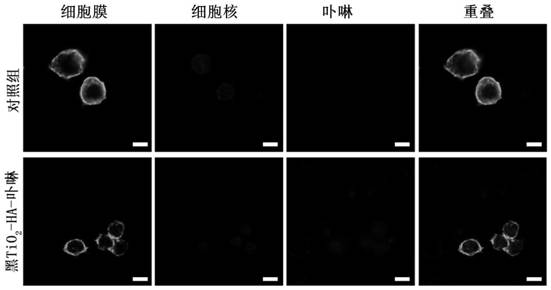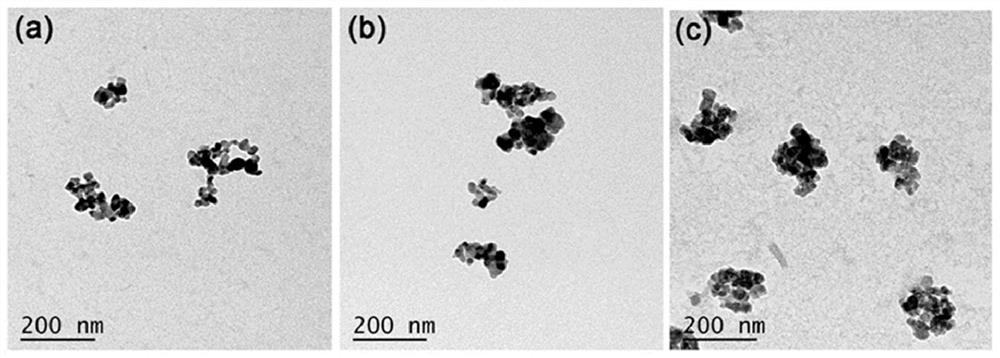Application of nano material in preparation of medicine for treating atherosclerosis
An atherosclerosis and nanomaterial technology, applied in the field of biomedical applications of nanomaterials, can solve problems such as changing the composition of plaques, accelerating the development of atherosclerosis, affecting the stability of plaques, and improving the therapeutic effect.
- Summary
- Abstract
- Description
- Claims
- Application Information
AI Technical Summary
Problems solved by technology
Method used
Image
Examples
Embodiment 1
[0087] Embodiment 1 core material black TiO 2 Preparation of nanoparticles
[0088] Sodium borohydride (NaBH 4 ) reduction method to prepare black TiO 2 nanoparticles. Weigh commercial P25 TiO 2 Nanoparticles 20.0 g, NaBH 4 5.0 g of powder, the two were mixed and ground for 60 minutes at room temperature with a mortar. The ground mixture was transferred to a ceramic boat, placed in a tube furnace, and heated at a rate of 10°C per minute from room temperature to 350°C in a high-purity Ar atmosphere for 180 minutes. Black TiO can be obtained after natural cooling of the reactants 2 Nanoparticles, dispersed in absolute ethanol, centrifuged at 11,000 rpm for 10 min, repeated 3 times, then dispersed in ultrapure water, centrifuged at 12,000 rpm for 15 min, repeated 4 times to remove residual NaBH 4 . Finally, place it in an oven at 70°C for 12 hours to obtain the core material black TiO 2 Nanoparticles.
Embodiment 2
[0089] Embodiment 2 core material black ZrO 2 Preparation of spherical nanoparticles
[0090] Take ZrO 2 20.0 grams of powder, 5 grams of sodium borohydride powder, mixed and ground for 30 minutes at room temperature. Put the mixed powder into a tube furnace, raise the temperature to 350° C. at a rate of 10° C. / min under the protection of argon, and heat and react for 4 hours respectively. After the reaction, the powder was dispersed into ultrapure water, centrifuged at 12,000 rpm for 20 minutes, repeated 3 times, then dispersed in absolute ethanol, and centrifuged at 12,000 rpm for 20 minutes to remove residual reactants. The centrifuged precipitate was placed in an oven at 80°C, and black ZrO was obtained after drying. 2 spherical nanoparticles.
Embodiment 3
[0091] Embodiment 3 core material black TiO 2 Preparation of hollow nanospheres
[0092] Take 10 ml of tetraethyl orthosilicate and add it to 200 ml of the mixed solution of ethanol, ammonium hydroxide and water (volume ratio of ethanol: ammonium hydroxide: water = 95:4:1), stir at 25°C for 8 hours, get SiO 2 kernel. 10 ml of isopropyl titanate was added to the reaction solution, and stirring was continued for 8 hours. After the reaction, centrifuge at 12,000 rpm for 30 minutes, repeat washing and centrifugation 3 times to obtain SiO 2 -TiO 2 Core-shell nanospheres. In order to remove SiO 2 core, the SiO 2-TiO 2 The core-shell nanospheres were dispersed in 1 mol / L sodium hydroxide solution and stirred for 6 hours. After the reaction, centrifuged at 12,000 rpm for 30 minutes, repeated washing and centrifuging for 3 times, and dried at 80°C for 6 hours to obtain white TiO 2 Hollow nanosphere powder. Take 5 grams of white TiO 2 Hollow nanospheres and 1.5 grams of sodiu...
PUM
 Login to View More
Login to View More Abstract
Description
Claims
Application Information
 Login to View More
Login to View More - R&D
- Intellectual Property
- Life Sciences
- Materials
- Tech Scout
- Unparalleled Data Quality
- Higher Quality Content
- 60% Fewer Hallucinations
Browse by: Latest US Patents, China's latest patents, Technical Efficacy Thesaurus, Application Domain, Technology Topic, Popular Technical Reports.
© 2025 PatSnap. All rights reserved.Legal|Privacy policy|Modern Slavery Act Transparency Statement|Sitemap|About US| Contact US: help@patsnap.com



